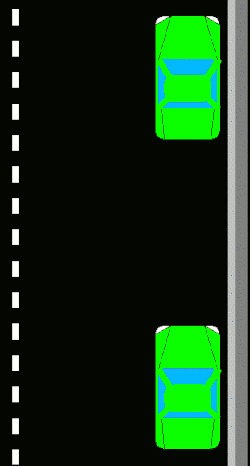Parallel parking: Difference between revisions
Jasper Deng (talk | contribs) |
|||
| Line 40: | Line 40: | ||
{{Commons category}} |
{{Commons category}} |
||
[[Category:Driving techniques]] |
[[Category:Driving techniques]] |
||
[http://sglearntodrive.com/ Learn parallel parking in Singapore] |
|||
Revision as of 02:25, 26 May 2014
This article relies largely or entirely on a single source. (March 2012) |



Parallel parking is a method of parking a vehicle in line with other parked vehicles. Parallel parking requires initially driving slightly past the parking space, parallel to the parked vehicle in front of that space, (hence the term 'Parallel Parking'), keeping a safe distance, then followed by reversing into that space. Subsequent position adjustment may require the use of forward and reverse gears.
Techniques
Parallel parking is considered to be one of the hardest skills for new drivers to learn. Parallel parking enables the driver to park a vehicle in a smaller space than would be true of forward parking. Driving forward into a parking space on the side of a road is typically not possible unless two successive parking spaces are empty. Reversing into the spot via the parallel parking technique allows one to take advantage of a single empty space not much longer than the car (in order to complete the parking within three wheel-turns the parking space would generally need to be about one and a half car-length long).
New drivers learn to use reference points to align themselves in relation to the car in front of the space, to determine the proper angle for backing, and to determine when to turn the steering wheel while backing. They may find it easier to briefly stop at each reference point and turn for the next step.
Steps
Two major types of parallel parking technique differ in whether they will use two or three positions of the steering wheel while backing. A skilled driver may be able to parallel park successfully by backing with the steering wheel turned all the way to the left (or right, in left-hand drive countries or when parking on the left side of a one-way street) and then immediately cranking the wheel all the way to the right (or left, in left-hand drive countries or when parking on the left side of a one-way street) at a critical point. For beginning drivers, those with larger cars or bad sight lines, this may risk collision with either the car in front of or behind the parking space, or it could also result in the car being parked too far away from the curb. Such drivers may find it easier to include an intermediate step, where after having achieved the ideal angle for backing up they back up with the wheels straight until the rear end of the car is far enough back to allow them to make their final reverse turn. While steering wheel positions in between full-right, straight, and full-left are possible to use, beginners may be able to gauge their progress more effectively by turning the wheel all the way to the right or left.
A 2009 Ruhr University Bochum study argued that a driver's gender may affect parking ability. According to the research, female drivers took an average of 20 seconds longer to park than male drivers, yet were still less likely than men to park accurately.[1]
In the early 21st century, car manufacturers are addressing this need by introducing automatic parking.
Road infrastructure
Roads that facilitate parallel parking have an extra lane or a large shoulder for parked cars. It is also employed whenever parking facilities are not available—usually in large metropolitan areas where there is a high density of vehicles and few (or restricted) accommodations such as multi-storey car parks.
Many jurisdictions restrict parallel parking during rush hour, freeing up an extra traffic lane. Historically, metered parallel parking had individual meters for each parking spot with spots clearly marked on the road. Some jurisdictions have eliminated individual spots allowing shorter vehicles to use less space. Individual meters are then also replaced with a centralized parking ticket machine.
Beyond taking up a lane of traffic, on-street parking further reduces road capacity as remaining traffic slows to interact with cars moving in and out of parallel parking spaces, car doors opening and pedestrians.[2]
See also


- Advanced Parking Guidance System
- Angle parking
- Perpendicular parking or bay parking
- Parallel parking problem: the mathematics of parallel parking
- Door zone
References
- ^ Moore, Matthew (2009-12-20). "Women worse at parking than men, study shows". London: telegraph.co.uk. Retrieved 2010-01-02.
- ^ http://www.konsult.leeds.ac.uk/private/level2/instruments/instrument039/l2_039b.htm
